-
Countries
-
Data and Analysis
-
Special Focus
-
Crisis Responses
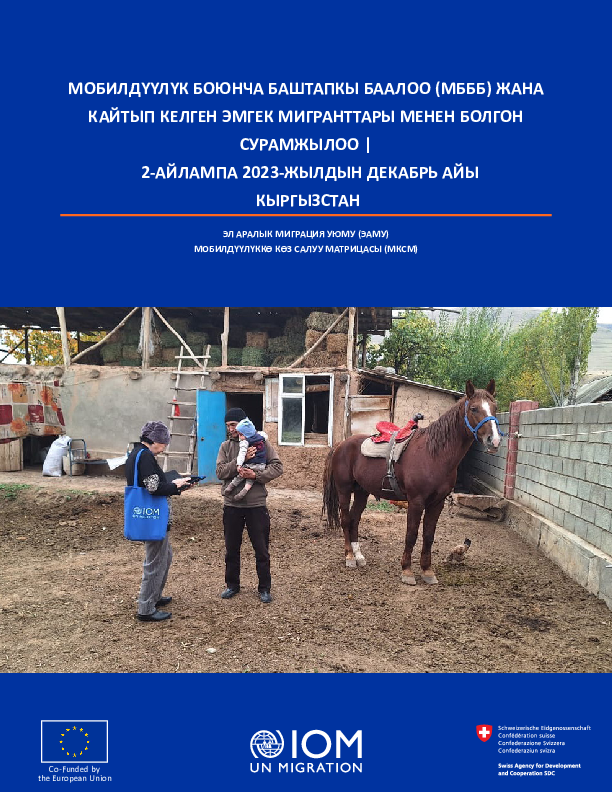
Contact
iomkyrgyzstan@iom.int
Language
English
Location
Kyrgyzstan
Period Covered
Dec 01 2023
Dec 31 2023
Activity
- Survey
- Flow Monitoring Survey
- Mobility Tracking
- Baseline Assessment
Мобилдүүлүктү көзөмөлдөө матрицасы (MКM) – бул калктын жер которуу жана мобилдүүлүгүн көзөмөлдөгөн жана ага мониторинг жүргүзгөн система. Бул система калктын жер которгон жеринде же жер которуу учурунда келип чыккан муктаждыктарын жакшыраак түшүнүү максатында, тынымсыз жана системалуу түрдө маалыматтарды топтоо, анализдөө жана ал маалыматтарды жарыялоо максатында иштелип чыккан.
2023-жылдын июнь-август айларында МКМ калктын мобилдүүлүгүнө көз салуу, жер которгондордун саны, эмгек мигранттарынын жана кайтып келген мигранттардын жайгашкан жери, миграциянын себептери, кайсы өлкөлөрдөн кайтып келгендиги жана миграцияда канча убакыт болгондугу жөнүндө маалымат берүү үчүн Кыргызстанда Мобилдүүлүк боюнча баштапкы баалоо (МБББ) экинчи айлампасын өткөрдү. МКМ ЭАМУна жана анын өнөктөштөрүнө ресурстарды максималдуу көбөйтүүгө, артыкчылыктуу багыттарды аныктоо жана максаттуу, далилдүү, мобилдүүлүкө тиешелүү туруктуу миграция саясатын жана иш пландарын иштеп чыгууга мүмкүндүк берет.

Contact
DTM Pakistan, DTMPakistan@iom.int
Language
English
Location
Pakistan
Period Covered
Apr 16 2024
Apr 30 2024
Activity
- Flow Monitoring
The International Organization for Migration (IOM) in Pakistan collects data on the outflows of Afghans at the Torkham (Khyber Pakhtunkhwa), Badini, Bahramcha and Chaman (Balochistan) border crossing points (BCPs) to better understand the movements of Afghans returning to Afghanistan. The data presented below is harmonised with those from the United Nations High Commissioner for Refugees (UNHCR), who also cover Ghulam Khan (Khyber Pakhtunkhwa).
On 26 September 2023, the Ministry of Interior in Pakistan announced its decision to enact its “Illegal Foreigners’ Repatriation Plan (IFRP)”. Between 16 and 30 April 2024, 16,547 Afghan nationals returned to Afghanistan, including 9,349 through the Torkham BCP, 6,945 through the Chaman BCP, 253 through the Ghulam Khan BCP, while no Afghan nationals returned through the Badini and Bahramcha BCPs. In addition, border authorities deported 518 individuals due to a lack of valid documentation. Since 1 January 2024, IOM identified 79,624 returns at the four BCPs.

Contact
dtmhaiti@iom.int
Language
English
Location
Haiti
Period Covered
Apr 25 2024
May 07 2024
Activity
- Mobility Tracking
- Event Tracking
The information below was collected following several armed attacks that occurred between 25 April and 5 May 2024, in the commune of Delmas, specifically in the neighborhoods of Cité Numéro 2 (Delmas 24) and Solino. As a result of these incidents, residents from six sites located in the neighborhoods of Cité Numéro 2, Carrefour Pean, 2ème cité Saint Martin, and Sylvio Cator - Delmas 28 were forced to evacuate these sites. In total, 5,178 individuals were displaced, including residents from these six sites and residents from the Cité Numéro 2 neighborhood. Internally displaced persons (IDPs) headed towards the communes of Port-au-Prince, Delmas, Croix-Des-Bouquets, and Tabarre. Among them, 51% found refuge with host families, while 49% settled in ten sites, including six new sites and four pre-existing sites.

Contact
IOMASTANA@iom.int
Language
English
Location
Kazakhstan
Period Covered
Oct 01 2023
Dec 31 2023
Activity
- Survey
- Flow Monitoring Survey
- Flow Monitoring
- Mobility Tracking
The quarterly report is developed by combining secondary data obtained from different sources, including government agencies, international organizations, non-profit entities, and other types of organizations. More specifically, the report on the fourth quarter of 2023 was derived from data of the Ministry of Internal Affairs, Bureau of National Statistics, and Border Service of Kazakhstan. The data was compiled through a combination of published sources and direct requests to the partners and government agencies.

Contact
DTM Ukraine, dtmukraine@iom.int
Language
English
Location
Ukraine
Period Covered
Feb 01 2024
Mar 31 2024
Activity
- Other
Over two years since the full-scale invasion of Ukraine, the humanitarian situation, especially near the frontline, has grown increasingly complex. In response, the International Organization for Migration (IOM) Data and Analytics unit has developed a frontline monitoring system to track mobility and critical needs of civilians in heavily conflict-affected areas. This system integrates three key components: the Mobility and Needs Assessments (MaNA), frontline settlement monitoring, and evacuation tracking. MaNA provides information about the estimated population disaggregated by sex and age at the hromada level and the estimated proportion of this population facing acute humanitarian needs. Frontline settlement monitoring provides granular baseline population estimates, as well as primary humanitarian needs in selected settlements within 25 km from the frontline to support scenario-planning and prepositioning of humanitarian assistance. In addition, IOM continuously monitors evacuations to provide humanitarian partners with data on the direction and scale of movements from selected settlements undergoing evacuation. Each component aims to support the coordination of effective humanitarian response, ensuring the safety and well-being of affected frontline populations.
• Overall exit movements from Ethiopia increased by 18% in the last month, marking the highest number of movements tracked since 2018, and an increase of 1% compared with the previous highest figure reported in December 2023 (18,119).
• The number of movements leaving Ethiopia due to conflict, violence or persecution multiplied more than eightfold between February (84) and March (731), which may be attributed to clashes between the Fano militia and government forces. In fact, all movements tracked due to conflict, violence or persecution departed the Amhara region, from where one in ten was looking for safety.
• Returns to Obock and Tadjourah decreased by 32% in the last month. This may be linked with the period of Ramadan, where the number of patrolling authorities in Yemen decreases and crackdowns on movements toward Saudi Arabia generally easen.
• The number of women (+9%) and children (+72%) tracked in Bossaso increased by more than a quarter (+27%). This increase was acute in girls, which more than doubled (+166%, from 121 to 322), while the number of boys increased by 44% (from 397 to 570).
• More than 400 migrants (385 Ethiopian, 25 Yemeni, and 1 Somali) were deported from Oman to Yemen, while in Ta’iz Governorate, a truck heading towards the north of the country that was smuggling 109 Ethiopian migrants was intercepted at a security checkpoint.
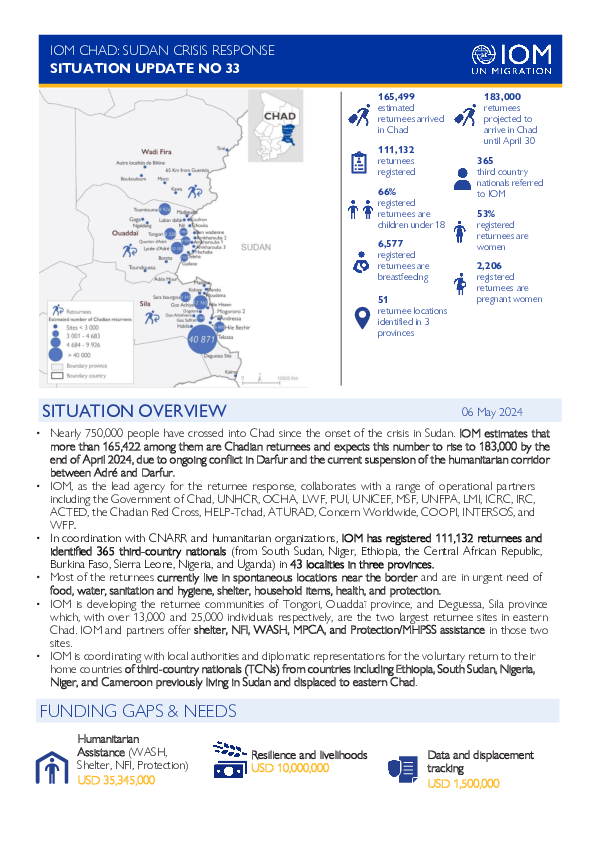
Contact
DTM Chad, dtmtchad@iom.int
Language
English
Location
Chad
Snapshot Date
May 06 2024
Activity
- Mobility Tracking
- Event Tracking
• Nearly 750,000 people have crossed into Chad since the onset of the crisis in Sudan. IOM estimates that more than 165,422 among them are Chadian returnees and expects this number to rise to 183,000 by the end of April 2024, due to ongoing conflict in Darfur and the current suspension of the humanitarian corridor between Adré and Darfur.
• IOM, as the lead agency for the returnee response, collaborates with a range of operational partners including the Government of Chad, UNHCR, OCHA, LWF, PUI, UNICEF, MSF, UNFPA, LMI, ICRC, IRC, ACTED, the Chadian Red Cross, HELP-Tchad, ATURAD, Concern Worldwide, COOPI, INTERSOS, and WFP.
• In coordination with CNARR and humanitarian organizations, IOM has registered 111,132 returnees and identified 365 third-country nationals (from South Sudan, Niger, Ethiopia, the Central African Republic, Burkina Faso, Sierra Leone, Nigeria, and Uganda) in 43 localities in three provinces.
• Most of the returnees currently live in spontaneous locations near the border and are in urgent need of food, water, sanitation and hygiene, shelter, household items, health, and protection.
• IOM is developing the returnee communities of Tongori, Ouaddaï province, and Deguessa, Sila province which, with over 13,000 and 25,000 individuals respectively, are the two largest returnee sites in eastern Chad. IOM and partners offer shelter, NFI, WASH, MPCA, and Protection/MHPSS assistance in those two sites.
• IOM is coordinating with local authorities and diplomatic representations for the voluntary return to their home countries of third-country nationals (TCNs) from countries including Ethiopia, South Sudan, Nigeria, Niger, and Cameroon previously living in Sudan and displaced to eastern Chad.
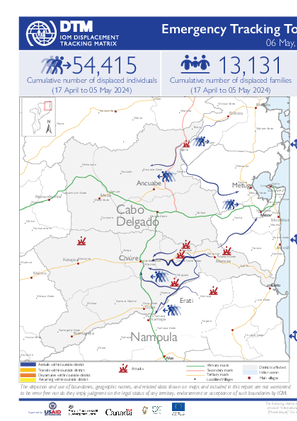
Contact
dtmmozambique@iom.int
Language
English
Location
Mozambique
Period Covered
Apr 17 2024
May 05 2024
Activity
- Mobility Tracking
- Event Tracking
Between 17 April and 5 May 2024, sporadic attacks, and fear of attacks by Non-state Armed Groups in Ancuabe, Chiúre and Erati triggered the cumulative displacement of 54,415 individuals/13,131 families. The current Movement Alert #110 reports on most recent attacks in southern Cabo Delgado. For more information on displacements between February and March, please see {Emergency Tracking Online Dashboard}.
Ancuabe attack | 2,959 Individuals displaced (17 April - 5 May 2024): Within the reporting period, attacks, and the fear of attacks by Non-State Armed Groups in Ancuabe led to the displacement of 2,959 individuals.
Chiure attack | 51,012 Individuals displaced (17 April – 5 May 2024): Within the reporting period, attacks, and fear of attacks by Non-State Armed Groups in Chiúre led to the displacement of 51,012 individuals.
Erati attack | 49,031 Individuals displaced (17 April – 5 May 2024): Within the reporting period, attacks, and fear of attacks by Non-State Armed Groups in Erati led to the displacement of 444 individuals.
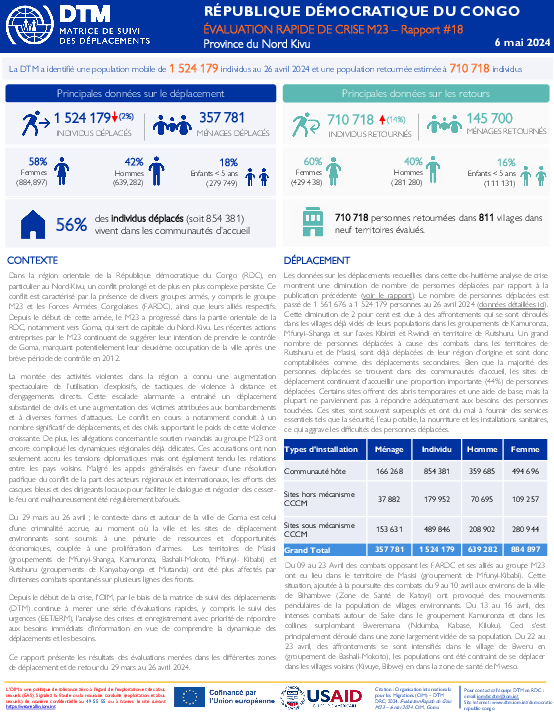
Contact
DTM DRC, iomdrcdtm@iom.int
Language
French
Location
Democratic Republic of the Congo
Period Covered
Mar 29 2024
Apr 26 2024
Activity
- Mobility Tracking
- Event Tracking
Dans la région orientale de la République démocratique du Congo (RDC), en particulier au Nord-Kivu, un conflit prolongé et de plus en plus complexe persiste. Ce conflit est caractérisé par la présence de divers groupes armés, y compris le groupe M23 et les Forces Armées Congolaises (FARDC), ainsi que leurs alliés respectifs. Depuis le début de cette année, le M23 a progressé dans la partie orientale de la RDC, notamment vers Goma, qui sert de capitale du Nord-Kivu. Les récentes actions entreprises par le M23 suggèrent leur intention de prendre le contrôle de Goma, marquant potentiellement leur deuxième occupation de la ville après une brève période de contrôle en 2012.
Depuis le début de la crise, l'OIM, par le biais de la matrice de suivi des déplacements (DTM) continue à mener une série d'évaluations rapides, y compris le suivi des urgences (EET/ERM), l'analyse des crises et enregistrement avec priorité de répondre aux besoins immédiats d'information en vue de comprendre la dynamique des déplacements et les besoins. Ce rapport présente les résultats des évaluations menées dans les différentes zones de déplacement et de retour du 29 mars au 26 avril 2024
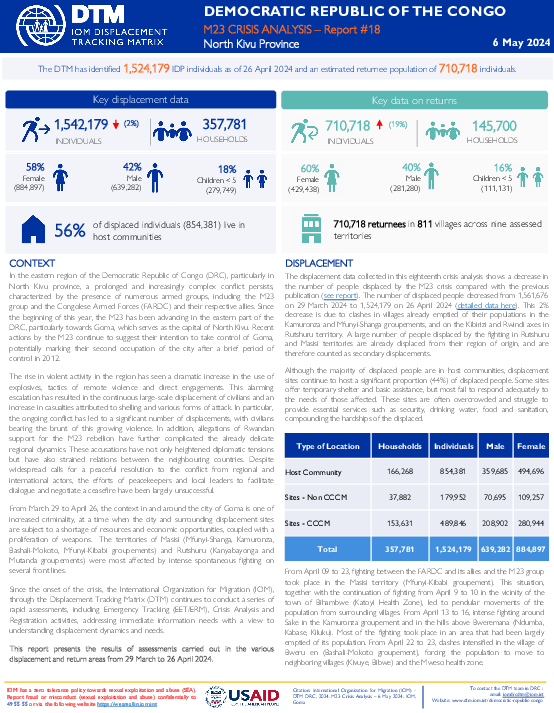
Contact
DTM DRC, iomdrcdtm@iom.int
Language
English
Location
Democratic Republic of the Congo
Period Covered
Mar 29 2024
Apr 26 2024
Activity
- Mobility Tracking
- Event Tracking
In the eastern region of the Democratic Republic of Congo (DRC), particularly in North Kivu province, a prolonged and increasingly complex conflict persists, characterized by the presence of numerous armed groups, including the M23 group and the Congolese Armed Forces (FARDC) and their respective allies. Since the beginning of this year, the M23 has been advancing in the eastern part of the DRC, particularly towards Goma, which serves as the capital of North Kivu. Recent actions by the M23 suggest their intention to take control of Goma, potentially marking their second occupation of the city after a brief period of control in 2012.
Since the onset of the crisis, the International Organization for Migration (IOM), through the Displacement Tracking Matrix (DTM) continues to conduct a series of rapid assessments, including Emergency Tracking (EET/ERM), Crisis Analysis and
Registration activities, addressing immediate information needs with a view to understanding displacement dynamics and needs. This report presents the results of assessments carried out in the various displacement and return areas from 29 March to 26 April 2024
